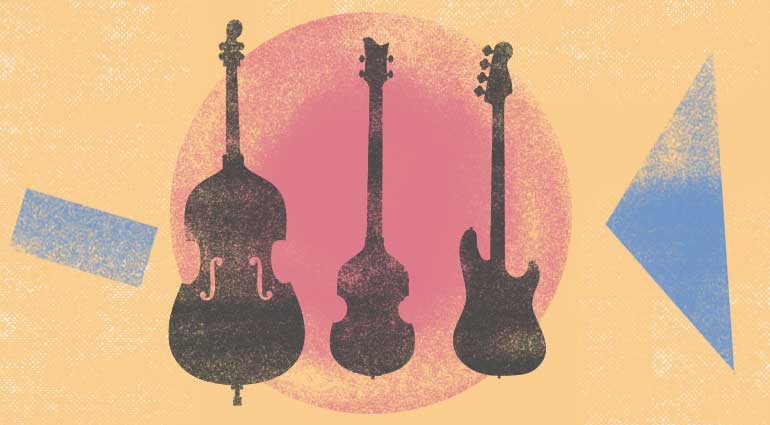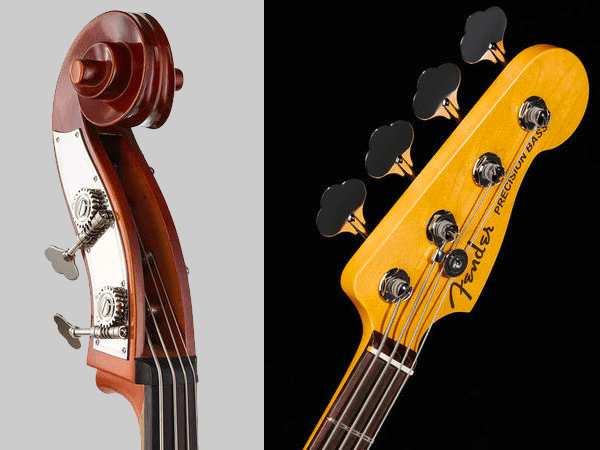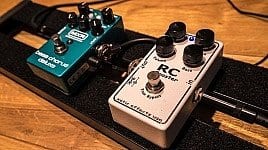
From double bass to electric bass
The electric bass has long been one of the most natural instruments in modern music. There is hardly a genre between jazz, rock, blues, country, pop and more, in which it is not responsible for the low frequency range. There were many practical reasons why it was invented in the first place and was intended to displace the double bass from the stage. Welcome to our timeline of bass evolution!
Why the double bass became the electric bass

Until 60 years ago, the low frequency range in live music was still reserved for the double bass. In jazz, swing, blues, and later also in rock ‘n’ roll, the bands became louder because, suddenly, drums and electric guitars were integrated into popular music. And in this thunderstorm you had to be able to keep up as a bass player. A double bass cannot deliver such volume due to its construction, so the electric bass stepped in, assertively, and took its place (in many genres).
The pragmatic transport problem
The double bass was – and still is – a wicked instrument, but at the same time a monster due to its dimensions and weight. The club and live scene became highly active and music was being played on every corner. The double bass, however, was difficult to transport, a logistical problem of the musical kind. How do you get such a colossus from one job to the next? Well, you could use a bass wheel but these don’t work in every circumstance (think about steep hills, stairs and the risks involved).
From vertical to horizontal
Unlike today, there were countless jobs for bass players. But trained bassists were always in short supply. The guitarists were offered gigs as double bass players, but they often couldn’t play them, especially since they would have had to retrain for the “vertical monster instrument”. A solution for this was needed and, coincidentally, bassists wanted to be mobile. This was made possible by the horizontal construction and playing position. They could simply hang the electric bass over their shoulders. Try that with a double bass.
Why were frets added?
Don’t forget that music was rapidly changing and with it the demands of the bass lines. A correct intonation especially for faster passages was difficult to achieve. A double bass does not have frets for orienting oneself, but even here a sensible solution was obvious. The experience with fretted string instruments was, after all, already available on guitars – both acoustic and electric. So why not combine the concepts of guitars and double bass?
How the strings changed
String manufacturers have also played an important role in the electric bass sound that is possible today. Due to sophisticated techniques in the manufacturing process, brighter sounds , which are more popular today, are possible with roundwound strings. The first electric basses had more of a similar sound to the double bass. For this reason they were equipped with flatwound strings that were very close to the gut strings (yes, guts, from animal intestines) of the double bass.
The strings on a double bass are so fat that the fingers are subjected to a great deal of strain, especially when slapping. It is quite common for bassists to tape their fingers. It’s different with the electric bass. Admittedly, you can easily get blisters on your fingertips, however, this is not comparable with the requirements of double bass strings.
- Evolution from flatwound
- to roundwound!
The innovator: Fender in the early ’50s
The first series-produced electric bass was developed by a certain Leo Fender together with George Fullerton. In 1951 the now legendary Fender Precision Bass came into the shops. The naming “Precision” referred to the fact that the first frets made precise intonation possible when playing.
The P-Bass was an absolute revolution especially for live musicians. Sure, the double bass was one of the most popular instruments in the early 20th century, in the bands it had its permanent place for the low frequencies. However, with its dimensions it was really difficult to transport. The electric bass, on the other hand, could be transported to gigs very easily.
- Fender Player Series P-Bass
- Fender 59 P-Bass
How the bass was electrified
The first Precisions by Leo Fender were rather rudimentary. On board they only had a single-coil pickup and a simple tone control with one volume and one tone control each. The treble could be reduced to get the sound quite close to that of a double bass.
Another decisive argument was that the electric bass was far less susceptible to feedback. Thanks to the electromagnetic pickups, the vibrations of the steel strings could now be precisely picked up, amplified and reproduced via amp and speaker. This made higher volumes possible; the bass could now assert itself better in louder bands.
- Fender Bassman 500 Head
- Fender Bassman 410 Neo cabinet
Development of the electric bass from 1950 to 2020
The instruments got better and better over the years and were more comfortable to play. Over the years 5-string, 6-string and other exotic variants have developed. In the course of the optimised sound possibilities and the improved playability, the electric bass also made the important step from strictly a “foundation” in the band to a solo instrument. And as can be observed in music despite all the innovations, the ’50s- and ’60s-inspired reissue models continue to be some of the most popular. Retro factor from the bass cellar!

1958 Fender P-Bass Reissue
A (very incomplete) list of groundbreaking electric bass players:
Carol Kaye – The Wrecking Crew
Jackie Fox – The Runaways
Kim Deal – Pixies / The Breeders
Kim Gordon – Sonic Youth
Esperanza Spalding
Tal Wilkenfeld
Meshell Ndegeocello
Roy Johnson – Lionel Hampton
Bill Black – Elvis Presley
James Jamerson – The Funk Brothers
Jack Bruce – Cream
John Entwistle – The Who
Paul McCartney – The Beatles
Les Claypool – Primus
Stanley Clarke
Jaco Pastorius
Mark King – Level 42
Flea – Red Hot Chili Peppers
Marcus Miller
Check them out online and at your local record store!
Last but not least, check out this video where our Julia tries out 5 different P-basses and gets you to guess which ones she is using. Let’s see how good your ear is!
You are currently viewing a placeholder content from Youtube. To access the actual content, click the button below. Please note that doing so will share data with third-party providers.
Also, this interview with Marcus Miller is definitely worth a watch:
You are currently viewing a placeholder content from Youtube. To access the actual content, click the button below. Please note that doing so will share data with third-party providers.
10 comments
Leave a Reply
You are currently viewing a placeholder content from Facebook. To access the actual content, click the button below. Please note that doing so will share data with third-party providers.
More InformationYou are currently viewing a placeholder content from Instagram. To access the actual content, click the button below. Please note that doing so will share data with third-party providers.
More InformationYou are currently viewing a placeholder content from X. To access the actual content, click the button below. Please note that doing so will share data with third-party providers.
More Information














City dave says:
I know you said incomplete, but you have 19 bassists there and no Wooten. That boggles my mind. Especially, considering you have Clarke and Miller on there.
Kevin says:
Yeah….where’s Victor?
Dale says:
Monk Montgomery was a long time bassist for Lionel Hampton
Jack B says:
And Billy Cox and Noel Redding? They played with the greatest guitar player of all time.
dave turissini says:
Thank you for your accuracy. The electric bass is an electric version of the double bass, not a bass version of the guitar. Only knuckleheads call it a bass guitar.
Grrrr says:
John Deacon? Chris Wolstenholme? Mike Kerr?
Lance McCormick says:
Phil Leah?
Lance McCormick says:
Lesh I meant!
Socalal says:
Berry Oakley
Publius Enigma says:
Good article. Don’t listen to the commenters who can only criticize or say “where’s what’s-his-name.” They always swoop down like vultures on these kinds of articles. Keep up the good work!